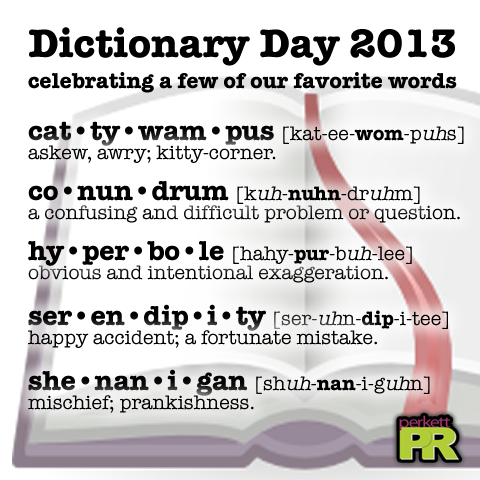This week you’ll see plenty of ghouls and goblins, tricks and surprises. But fear shouldn’t be a part of your PR campaign! Here are our tips for avoiding ghoulish PR. (And if you need some help, who ya gonna call?!)

This week you’ll see plenty of ghouls and goblins, tricks and surprises. But fear shouldn’t be a part of your PR campaign! Here are our tips for avoiding ghoulish PR. (And if you need some help, who ya gonna call?!)
Ok, so there may not be presents, fireworks or candy to mark the occasion, but we can assure you that lexicographers across the country are certainly celebrating today. (Don’t know what a “lexicographer” is? There’s no better way to partake in this unofficial holiday than to break out your dictionary!)

Why? Noah Webster, otherwise known as the “father of the American dictionary,” was born today in 1758. Fun fact: It took him 27 years to complete his first dictionary in the English language!
But rather than break out our dusty books in honor of the event, we thought we’d pay homage by talking about what’s inside them, as that’s the true impetus behind this annual observance.
See, as PR professionals, we rely on the word (both written and spoken) daily. Just as Edward Bulwer-Lytton said in 1839, “The pen is mightier than the sword,” we, too, know the power of words and their ability to inform, inspire and even incite action.
Whether we’re writing a pitch, press release or bylined article, we’re constantly aware of the words we choose – and how their tone and meaning will be interpreted. In fact, as we’re creating and circulating information on behalf of our clients, we strive to stay adept at striking a balance between keeping the messaging consistent and the language fresh.
So take a few moments today to open or click onto a dictionary, and peruse a few new words to add to your vocabulary. If you’re in need of some inspiration, go to www.worldwidewords.org, or check out our infographic above, which highlights a few of our personal favorites. We’d also be remiss if we didn’t include a few words from Mark Twain, a man who had a definite way with them:
“The difference between the right word and the almost right word is the difference between lightning and a lightning bug.”
The lesson here for us PR folks? Words are the building blocks for success, as they can help you communicate more clearly, yield better results and separate yourself and your clients from the competition. Use them wisely!
“How do fevers in the human brain produce the dreams and visions that become transformed into blazes of insight?” The Creative Brain
When I was in college, I was proud to be studying at a University that had its PR program in the School of Business, resulting in a Bachelor of Science in Business degree. This was – and stills seems to be – a rarity in the field. Most PR and Marketing degrees are housed in the School of Communications and/or result in a Bachelor of Arts. In the past, this seemed to make sense for PR – it reflected the creative arts side of the field – writing, event planning, branding, messaging, etc. But today, with the explosion of analytics and data in the field, PR and Marketing executives have to think differently. They need to use both sides of their brain – the right, creative side and the left, analytical side. (Luckily, my degree prepared me for both before the market turned that direction.)
The creative side of the brain is still crucial to coming up with marketing strategies, branding and messages that appeal to people. We have to understand how to entice strong emotions that lead to action. Once that action is taken, we now have to use the right side of our brain to determine if that action resulted in value to our organization (or our clients’ organizations). Our creativity is crucial when it comes to content – we are in fact content creators and publishers in the day and age of social media. It takes fun, whimsy and innovative risk taking to create content that’s really going to stand out. But in order to truly create the best content, we need to use the right side of our brain to analyze how that content – if that content is working.
It’s not enough anymore to say “That was a really catchy headline” or “The logo is awesome” - or even to just write a creative pitch that gets a reporter’s attention. We now need to drill down and, after the reporter writes his or her article, analyze if the messages within drove the right interest. Was the article placed in the right outlet? Did the messages appeal to the right audience? What did they do as a result? Did they click through to our site? Did they buy? Why or why not?
This movement is also reflected in the banter about CIOs and CMOs battling for budget and suddenly sharing some tech responsibilities. CMOs are responsible for more data-driven decisions than in the past, and that includes managing the website’s content (which CIOs also need to make sure doesn’t then result in slower performance or other issues), and purchasing analytical software. As Dell chief information officer Andi Karaboutis recently told ZDNet, “Things for which I work together with Karen [the CMO]? Analytics, big data.”
And thus, today’s best PR and Marketing executives are what I’ve dubbed “Creatalitics” thinkers. They combine really creative and innovative ideas – those “dreams and visions” with data and analysis – the “blazes of insight” that tells them if their creations go beyond initial appeal and into the world of actionable value to the company’s bottom line. How are you using “creatalitics” in your PR or marketing position? If we can help you better undersatnd and merge this new way of thinking into your organization, let me know.
![cp_2013_smb_influencer_champion[4]](../../wp-content/uploads/2013/10/cp_2013_smb_influencer_champion41-300x300.png) Over the last 20 years, I’ve been blessed to not only run my own small business, but to work with hundreds of other small business owners, managers and startup founders. I’m fanatical about helping entrepreneurs to reach their career goals by starting, running and growing successful small businesses. Sometimes they grow into very large businesses – and that’s fun, too! But the crux of my career has been focused on helping to establish and promote companies in the early stages of their lifecycles, and I really enjoy those challenges.
Over the last 20 years, I’ve been blessed to not only run my own small business, but to work with hundreds of other small business owners, managers and startup founders. I’m fanatical about helping entrepreneurs to reach their career goals by starting, running and growing successful small businesses. Sometimes they grow into very large businesses – and that’s fun, too! But the crux of my career has been focused on helping to establish and promote companies in the early stages of their lifecycles, and I really enjoy those challenges.
That’s why I was so happy to be honored last week when I was named a Small Business Influencer Top 100 Champion and Expert in the 2013 Small Business Influencer Awards - produced by Small Business Trends, an award-winning online publication, serving over 6,000,000 small business owners, stakeholders and entrepreneurs annually, and SmallBizTechnology.com, a media company that produces online content and live events educating small and mid-sized companies on how to strategically use technology as a tool to grow their businesses. The awards honor those who are influential to small businesses in North America, through the products, services, knowledge, information or support they provide to the small business market.
I’m flattered to be in this list with some former clients (Brainshark, Constant Contact), companies I admire and use daily (Dropbox, American Express OPENForum, Evernote, Etsy, FedEx, Hootsuite, Hubspot, Plantronics, Vistaprint) and industry folks that I admire such as John Jantsch, Laurie McCabe, Dave Kerpen, Larry Kim and Aliza Sherman. Congratulations to all the other winners and honorable mentions, as well as the nominees. I fully support and cheerlead anyone who works in, and strives to help, small business. You can read about all the champions, here.
I simply wanted to say thank you to those who voted for me, the judges and most certainly my team at PerkettPR. They are not only a huge part of making our national clients successful through smart digital marketing and PR, but they are also an inspiration to me every day to keep my own small business innovative, fun and alive.
You can read additional details here, visit the award site or follow along on Twittter by searching #SMBInfluencer.

Photo courtesy of Tech Cocktail
PR practitioners used to have it easy! Remember the good ‘ol days when it was all about our media relationships and campaigns were linear, like this?
Ok, that’s simplifying things quite a bit, but you know what we mean.
Now, though, the entire landscape has changed with the explosion of the Internet, which has removed virtually all barriers to publication. Suddenly we’re responsible not only for the message, but also the mode and the medium, which follows more of a vicious cycle:
Software Advice‘s article on The B2B Marketing Mentor does a great job of explaining the creation and importance of this new kind of role that merges marketing, PR and journalism functions.
In an nutshell, since we now play a larger part in the production of content (journalism), we’re no longer simply pitching and promoting it (PR), but are challenged to leverage it as a strategic tool for lead generation and brand awareness (marketing).
The only problem is that, well, everyone else is doing the same thing, which means it’s pretty noisy out there as we all compete for the time and attention of our audiences.
That’s where the shift to “inbound” comes in; it’s an offshoot of content marketing that focuses on aligning content with customer interest so that they are “pulled” toward your company, rather than the old-school spray-and-pray methods.
We’ve embraced this, both in theory and in action, with our clients. In fact, we recently attending the Inbound Marketing Summit in San Francisco and the Inbound Marketing Conference in Boston where we talked about how it’s not about being the loudest; it’s about having the right content for the right audience at the right time.
Put simply, the only way we can guarantee our clients are in the media nowadays it to help them become the media. Content has become their new currency when attracting, engaging, converting and retaining customers.
Savvy PR professionals are embracing their status as content custodians. But the most successful ones will recognize the beauty in marketing’s ability to measure return and directly tie to their clients’ bottom line.